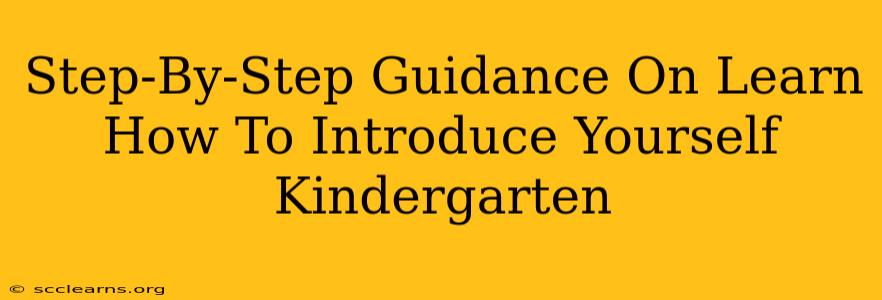Starting kindergarten is a big step! For many children, it's their first experience in a formal school setting, away from the familiar comfort of home. One of the first hurdles they'll face is introducing themselves to their teacher and classmates. This seemingly simple task can be daunting for some little ones. This guide provides a step-by-step approach to help your kindergartener master the art of self-introduction, building confidence and making new friends.
Understanding the Importance of Self-Introduction
Before diving into the how-to, let's understand why introducing yourself is important. A confident self-introduction:
- Builds confidence: Successfully introducing themselves boosts a child's self-esteem and encourages them to participate more actively in class.
- Facilitates friendships: Knowing how to introduce themselves helps children connect with their peers, forming the foundation for friendships.
- Impresses teachers: It shows the teacher that your child is comfortable and ready to learn.
- Develops social skills: This is a fundamental social skill used throughout life.
Step-by-Step Guide: Mastering the Kindergarten Self-Introduction
Here's a practical, step-by-step plan to help your kindergartener confidently introduce themselves:
Step 1: Practice at Home
- Role-playing: Practice introducing yourselves to each other. You can take turns being the teacher or classmate.
- Use a mirror: Encourage your child to practice in front of a mirror. This helps them see their facial expressions and body language.
- Keep it simple: Start with a basic introduction: "Hi, my name is [child's name]."
- Add a detail: Gradually add a detail, like "Hi, my name is [child's name], and I like to play with cars." Keep it short and sweet!
- Positive reinforcement: Praise their efforts and celebrate their progress.
Step 2: Visual Aids and Games
- Flashcards: Create flashcards with the words "Hi," "My name is," and your child's name.
- Name train: Use blocks or toy trains to create a "name train" with each child's name on a separate piece. This is a fun way to learn names and introduce yourselves.
- Puppet show: Use puppets to act out self-introductions. This can make the process more playful and engaging.
Step 3: Introduce Yourself in Different Settings
- Playdates: Encourage your child to introduce themselves to other children during playdates.
- Family gatherings: Practice introducing themselves to family members and friends.
- Grocery store: In a less pressured setting, practice introducing themselves to the cashier (with your supervision, of course!).
Step 4: Kindergarten Day Prep
- Visual reminder: Create a small visual cue (e.g., a picture of your child with their name written underneath) to help them remember their name.
- Role-play the scenario: Practice saying "Hi, my name is..." before heading to school. Imagine the classroom setting and walk through the introduction.
- Positive affirmation: Remind your child that it’s okay to be a little nervous and that everyone feels that way sometimes.
Step 5: Teacher Collaboration
- Communicate with the teacher: Let the teacher know you're working on this skill at home.
- Teacher's support: The teacher can reinforce this skill in the classroom by having the children introduce themselves to each other in various group activities.
Handling Nervousness
It’s normal for children to feel nervous when meeting new people. Here are some tips for handling nervousness:
- Deep breaths: Teach your child to take slow, deep breaths to calm themselves.
- Positive self-talk: Encourage positive self-talk, such as "I can do this!" or "I'm going to make new friends."
- Focus on the positive: Help your child focus on the fun aspects of kindergarten, like playing with new toys or making new friends.
By following these steps and remaining patient and supportive, you can help your kindergartener confidently navigate the world of self-introductions and build a strong foundation for a successful school year. Remember, every child learns at their own pace, so celebrate small victories along the way!

